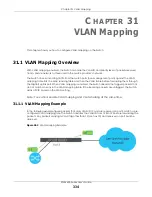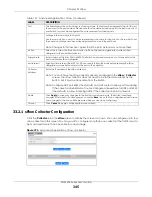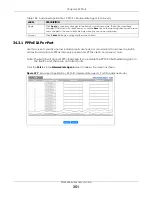
Chapter 32 Layer 2 Protocol Tunneling
XGS4600 Series User’s Guide
341
The following table describes the labels in this screen.
Table 146 Advanced Application > Layer 2 Protocol Tunneling
LABEL
DESCRIPTION
Active
Select this to enable layer 2 protocol tunneling on the Switch.
Destination
MAC Address
Specify a MAC address with which the Switch uses to encapsulate the layer 2 protocol packets
by replacing the destination MAC address in the packets.
Note: The MAC address can be either a unicast MAC address or multicast MAC
address. If you use a unicast MAC address, make sure the MAC address does
not exist in the address table of a switch on the service provider’s network.
Note: All the edge switches in the service provider’s network should be set to use the
same MAC address for encapsulation.
SLOT
This field appears only in stacking mode. Click the drop-down list to choose the slot number of
the Switch in a stack.
Port
This field displays the port number. In stacking mode, the first number represents the slot ID and
the second is the port number. Please note that the default stacking ports (the last two ports of
your Switch) cannot be configured. They are reserved for stacking only.
*
Use this row to make the setting the same for all ports. Use this row first and then make
adjustments on a port-by-port basis.
Note: Changes in this row are copied to all the ports as soon as you make them.
CDP
Select this option to have the Switch tunnel CDP (Cisco Discovery Protocol) packets so that
other Cisco devices can be discovered through the service provider’s network.
STP
Select this option to have the Switch tunnel STP (Spanning Tree Protocol) packets so that STP can
run properly across the service provider’s network and spanning trees can be set up based on
bridge information from all (local and remote) networks.
VTP
Select this option to have the Switch tunnel VTP (VLAN Trunking Protocol) packets so that all
customer switches can use consistent VLAN configuration through the service provider’s
network.
LLDP
Select this option to have the Switch tunnel LLDP (Link Layer Discovery Protocol) packets so that
all network devices can advertise its identity and capabilities through the service provider’s
network.
Point to Point
The Switch supports PAgP (Port Aggregation Protocol), LACP (Link Aggregation Control
Protocol) and UDLD (UniDirectional Link Detection) tunneling for a point-to-point topology.
Both PAgP and UDLD are Cisco’s proprietary data link layer protocols. PAgP is similar to LACP
and used to set up a logical aggregation of Ethernet ports automatically. UDLD is to determine
the link’s physical status and detect a unidirectional link.
PAGP
Select this option to have the Switch send PAgP packets to a peer to automatically negotiate
and build a logical port aggregation.
LACP
Select this option to have the Switch send LACP packets to a peer to dynamically create and
manage trunk groups.
UDLD
Select this option to have the Switch send UDLD packets to a peer’s port it connected to
monitor the physical status of a link.
Содержание XGS4600 Series
Страница 24: ...24 PART I User s Guide ...
Страница 44: ...44 PART II Technical Reference ...
Страница 180: ...Chapter 13 Spanning Tree Protocol XGS4600 Series User s Guide 180 Figure 145 MSTP and Legacy RSTP Network Example ...
Страница 189: ...Chapter 16 Mirroring XGS4600 Series User s Guide 189 Figure 150 Advanced Application Mirroring Standalone Mode ...
Страница 244: ...Chapter 22 Policy Rule XGS4600 Series User s Guide 244 Figure 189 Policy Example EXAMPLE ...
Страница 277: ...Chapter 25 Multicast XGS4600 Series User s Guide 277 Figure 215 Advanced Application Multicast MVR Standalone Mode ...
Страница 559: ...Chapter 59 Access Control XGS4600 Series User s Guide 559 Figure 460 Example Lock Denoting a Secure Connection EXAMPLE ...
Страница 586: ...Chapter 69 Configure Clone XGS4600 Series User s Guide 586 Figure 479 Management Configure Clone Standalone Mode ...
Страница 587: ...Chapter 69 Configure Clone XGS4600 Series User s Guide 587 Figure 480 Management Configure Clone Stacking Mode ...
Страница 594: ...Chapter 71 Port Status XGS4600 Series User s Guide 594 Figure 485 Management Port Status Port Details Standalone Mode ...
Страница 604: ...604 PART III Troubleshooting and Appendices ...






























